

 |
The Farnsworth
Invention: Fact -v- Fiction
|
 |
Act I, Scene 6: The damn thing works! |
| The Play |
The Facts
|
|
As Phil, Pem, and others arrive at 202 Green Street, they are introduced to a Cal Tech student named Stan Willlis, who says he has been hired by Mr. Crocker to help with the work "for class credit." Phil introduces wife Pem, his sister Agnes, and Pem's brother Cliff Gardner. |
Farnsworth and his entourage arrived at 202 Green Street in September, 1926. Stan Willis is a fictional character, but the others were all part of the 202 Green Street operation. |
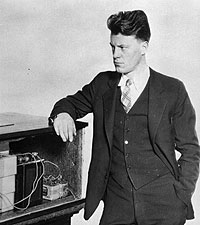 Carl Christensen, a real member of the lab gang not mentioned in the play |
| Cliff Gardner volunteers to fabricate the glass tubes that Farnsworth will need for his experiments. | Cliff Gardner taught himself glass blowing and became a pivotal member of Farnsworth's lab gang. | 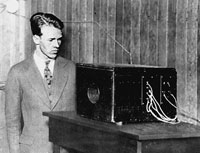 Cliff Gardner, who built the first television camera tubes with his own hands |
| Later in the scene another character enters and introduces himself as "Harlan Honn." Honn explains that he is working on a refrigeration system in a space across the hall. | There was an engineer named Harlan Honn who was called in after Farnsworth's presentation for the bankers to sign off on the practicality of the idea. "Why sure, this will work," Honn said, which assessment was instrumental in Farnsworth obtaining his $25,000 stake. Honn's operation was in the same building as Farnsworth's but Honn was not part of the "lab gang." | 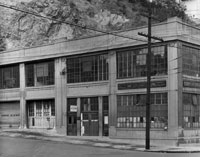 "Television Labs" was on the second floor |
| Phil asks Stan Willis what he knows about moving pictures. Stan describes the phenomenon of "persistence of vision," where the eye is fooled by motion picture film flashing by "16 frames per second." | In the silent movie era, motion pictures flashed by at 16 frames per second. When sound was added in 1927, the frame rate was also increased, to 24fps |
|
| After Sarnoff-as-narrator insists that his experts have assured him that what is about to happen here is impossible, there is a dramatic reading of passages from Farnsworth's first patent application. | Patent # 1,773,980 was filed in January 1927 and granted in August 1930. The critical language which is not in the play is Claim 15:
And that, simply put, is the language that announces the arrival of electronic video on planet Earth. |
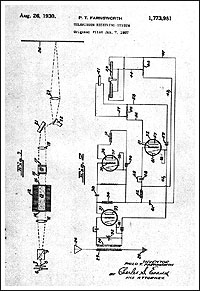 One of Farnsworth's first three television patents, granted in August, 1930 |
| After the patent is signed, sealed and delivered, the lab gang gets ready to conduct its first experiment. A generator blows up and fries everything. George Everson asks " do you have anything to show for all our money?" Somebody then tells Phil, "you have five weeks left..." | There was such an event while Phil and Pem were getting started in Los
Angeles in the summer of 1926. Much as depicted here, a switch was flipped,
power surged, and circuits melted. Les Gorrell just looked at the mess and
said, "but we still have Phil's ideas..." And since this event
happened before they even got to San Francisco, they had more than a year
to keep working. |
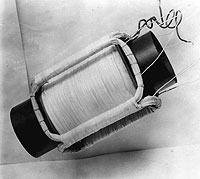 One of the first magnetic deflection harnesses, hand-wound by George Everson |
| "The six months are up." Crocker is coming to the lab to see a picture. Pem threatens not to make love to Phil until he's got a picture . | Good theater, bad history. Likewise the part where Phil is portrayed, again, nursing a bottle of Bushmill's. | |
| After numerous failed attempts at building a decent camera tube, Cliff Gardner shows up with one that might work. | The tube that finally worked was not the first that Cliff built himself. He mastered the art of glass blowing quite quickly, and built numerous Image Dissectors that were tested in the summer of 1927. | 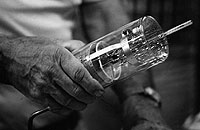 In 1977, Cliff Gardner built this replica of the first successful Image Dissector for the 50th Anniversary. |
A triangle is suspended from on a pendulum front of the Image Dissector tube and a curtain is pulled across the stage, separating the room with the camera from the room with the receiver. Everything is turned on. Nothing blows up. Nothing appears on the screen but 'electronic fog' -- and a wavy line running up the middle. Then somebody notices that the camera has been knocked off center, and they are seeing smoke from Pem's cigarette curling up the screen. Cue the music, it's chicken skin time. |
Another compression of actual events. On September 7, 1927, the image of a simple straight line was transmitted from an Image Dissector to a CRT Farnsworth called the "Oscillite." The principle that had struck him 6 years earlier in a potato field was proven. In subsequent experiments, a triangle was used to convey two dimensions. A couple weeks after that, smoke from a cigarette accidentally left in front of the camera conveyed motion and the first signs of subtle details. The cigarette belonged to Cliff Gardner, NOT Pem. |
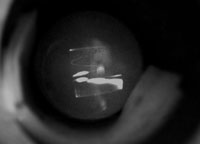 This replica of the Oscillite tube shows a replica of the first image, recreated in September 1977. There is a video of this image on YouTube as well. |
There is great rejoicing. |
After a number of unsuccessful tests over the preceding weeks, this time Farnsworth wrote in his journal, "the received line picture was evident this time." And Les Gorrell sent a telegram to George Everson: "The damn thing works!" | |
| The scene ends with Farnsworth and his magic tubes being photographed for the San Francisco Chronicle. | An article heralding "SF Man's Invention to Revolutionize Television" appeared in the San Francisco Chronicle a year later, on September 3, 1928. In the photo, Farnsworth sports a moustache -- so that he might look older than his 22 years. | 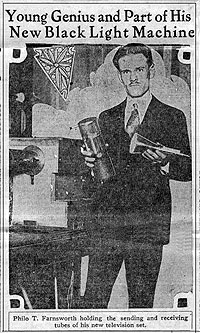 |
Want the whole story? Read a Book! |
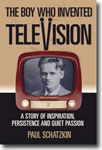 The Boy Who Invented Television A Story of Inspiration, Persistence, and Quiet Passion by Paul Schatzkin |
|